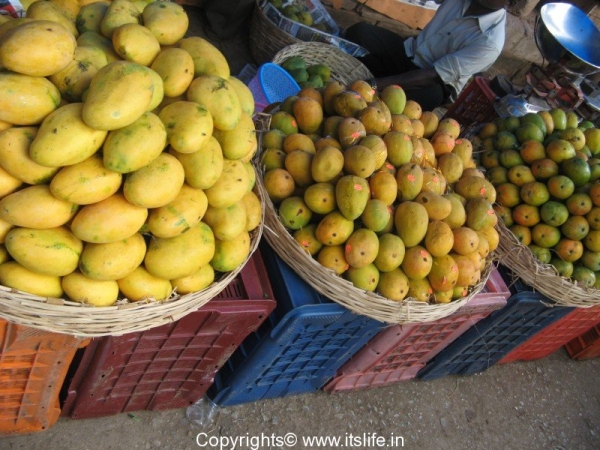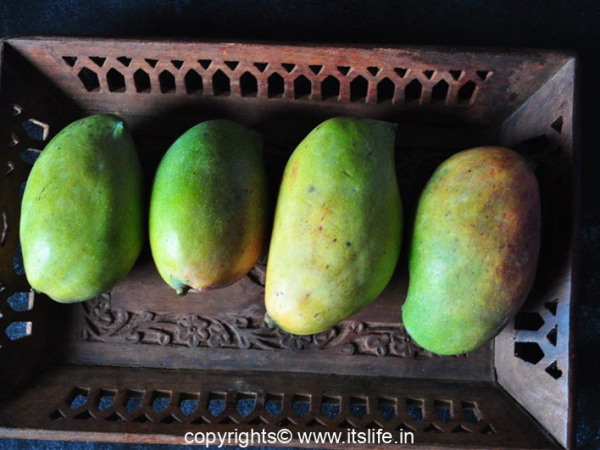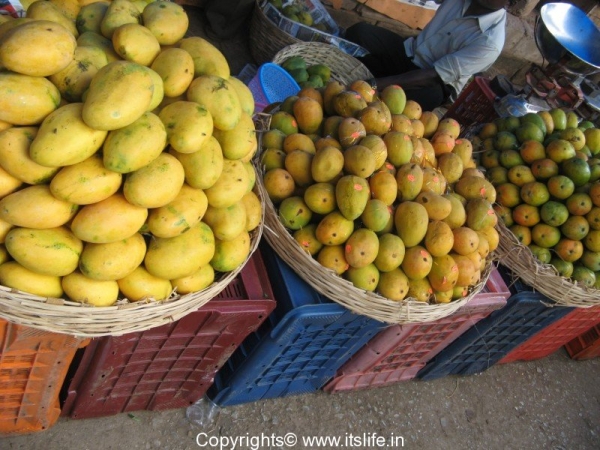Come summer and we are spoilt for choice on the type of Mango to buy. The markets are flooded with all shapes, colors, and sizes of Mangoes from all over the country. I remember eating dozens of something called as Country Mango at my Uncle’s Mango grove.
At home, we would gorge on the king of fruits after every meal. Mom would quip “Undu Mavu Hasth Halasu”, meaning, “Mango after meal, Jackfruit when hungry”. I love trying out all varieties available in the market, some blows me away and some I cringe at the taste. Here is an attempt to introduce the different types of Mangoes available in the market.
Raspuri
Pride of South Karnataka, Raspuri is a must-have in all Mysore region houses. As you grow up watching your parents buy Raspuri, you acquire and perfect the art of sniffing and identifying the original ones. The sniff is heady, and you already imagine biting into a juicy part of the Mango.
Raspuri is grown in and around Bengaluru, Ramanagara, Kolar, Chikkaballapura, Tumakuru. The color of the fruit is a yellow and green with a pleasant aroma. Raspuri as the name suggests is extremely juicy and great to make juices, milk shakes, smoothies, jams, and sauces.
The best Raspuri is available during the month of May.
Badami
At our home, Badami mangoes were bought only after Raspuri mangoes disappeared from the market. Badami mangoes are a distant albeit inferior cousin of Alphonso variety. Available from May to June.
Thothapuri
Thothapuri also known as Gini moothi (parrot face) mangoes are eaten raw with some salt and chilly powder. They are sour and sweet and has a unique flavor. A favorite among youngsters, you will find many stalls selling the cut fruit. Available from March to July.
Malgoba
There was a huge Malgoba tree at my Grandmother’s sister’s house in Mysore. I used to drool at all the huge mangoes hanging from the tree. Sometimes one of my aunt used to treat us with chopped raw mango drizzled with some salt and chili powder. The ripe fruits were sweet and flavorful.
Malgova or Malgoa is grown in South India. It is a green with shades of yellow, large round and heavy fruit. Each fruit will weight around 300 to 500 gm. The pulp is light yellow, and the stone is thin and small. Available in May and June.
Alfonso
Alfonso is popular in North Karnataka and Maharashtra. The fruit is a golden color with red tints. A beautiful fruit with an equally sweet and fibreless flesh. It is the most elite of all the varieties and is the most expensive.
Banganapalli
The past decade or more has seen a deep diffusion of Banganapalle mangoes in the Karnataka market. Banganapalle is a place in Andhra Pradesh. Good news! as this fruit is large, sweet with a lot of pulp and a thin seed. The flavor is again an acquired taste. The skin of this oval shaped fruit is extremely thin and is a light yellowish green shade with few spots. Available from May to July.
Mallika
Mallika is the result of Neelam and Dasheri variety hybridization. It is a long fruit with a thin stone. The pulp is a deep orange and sweet. Available from June to July.
Neelam
Neelam is grown in South India. When Neelam hits the market, we would know that it is the end of Mango season. We would also hesitate to buy these as they would be infested with worms. Now, it is not a sign of the end of season of Mangoes nor are they infested with worms. The improved varieties available now are juicy with lot of flesh and sweet. Available from June end to August.
Kalapad
Kalapad is grown in Andhra Pradesh. The pulp is deep Yellow and sweet.
Sindura
Sindura are red on the outside with yellow sweet flesh. Not the elite variety but good to make juice and milk shakes. Available from June to July.
Shakkarekatti
Shakkerekatti mangoes are the smallest of all mangoes. These are eaten whole and cannot be cut as they are extremley fibrous. They are also known as Shakkargutli, Sugar baby, and Sakkar putani.
Salem Gundu
These big mangoes are grown in Salem region of Tamil nadu. They are round and huge. Each one may weight 500 to 800 gm. The flesh is sweet with a distinct aroma.
Rumani
Rumani mangoes are also known as Apple Rumani and is cultivated in Chittor district. The Mango looks like an Apple. The skin is very thin and the fruit is juicy and flavorful.
Dasheri
After all the South Indian varieties exit from the market, Dasheri makes an entrance. Though tiny with a green exterior, the fruit is orange and very sweet. It is also known as Malihabadi mango and is cultivated in Malihabad located in Uttar Pradesh.
Langda
Langda is grown in Varanasi, Bihar, Haryana, Madhya Pradesh, Odisha, West Bengal and Punjab. Available in July.
Chaunsa
Chaunsa is a sweet mango grown in North India. These are available from June to August.
Kesar
Kesar mangoes is grown in Gujarat and as the name suggests it has a saffron fragrance. It is a sweet and juicy fruit.
Himsagar
Himsagar mangoes are grown in West Bengal and Odisha. The skin is thin and the taste of the fruit is sweet. Available in June.
Imam Pasand
Yet another variety of Mango to tickle our taste buds are the Hamam Mango, Imam Pasand or Himayat or Himam Pasand. This type of Mango cultivar is grown extensively in Srirangam, Tamil Nadu.
The Mangoes are large and weight around 400 grams to 1000 grams. They are available during May and June. The name hints that this Mango could have been the favourite of the Mughals. It has thin skin and a thin stone making room for more sweet flesh.
Jardalu
Jardalu Mango is from Bhagalpur, Bihar. It has light yellow skin and a unique pleasant aroma.
Mancurad
Mancurad Mango is from Goa. The original name was Hilario. These have Orange, string less pulp, which is delicious.
Australian Sweet Mango




